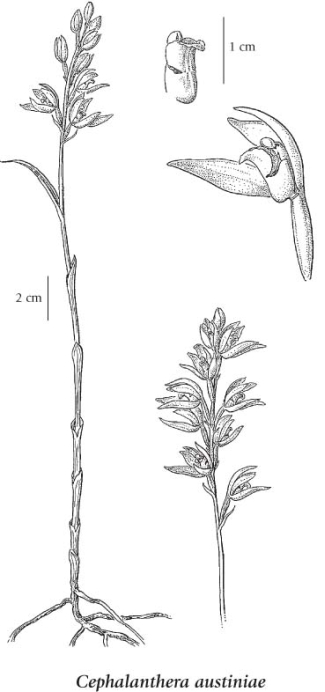phantom orchid
Orchidaceae (Orchid family)
Introduction to Vascular Plants
Photograph
© Dane Springmeyer (Photo ID #4725)
Introduction
The phantom orchid is a perennial, rhizomatous species that grows primarily in shade on rich soils (Wilkens and Jennings 1993) in mixed and coniferous mature and old-growth forests. In North America, it is found in British Columbia, Washington, Oregon, Idaho and California (USDA 2010). In BC, it is reported as "rare in the lower Fraser Valley, SE Vancouver Island and the Gulf Islands" (Douglas et al. 2001). In these areas, plants have been observed along foot paths, beside deer trails, and in deer beds, often on calcareous sites.
This is a distinctive species of wild orchid. It is almost totally white with a noticeably reflexed yellow lip. Leaves are bract-like and mostly sheath the stems. Flowers are in a terminal raceme of 5 to 20. The flowering period is long: the earliest reported flowering date for the phantom orchid in BC is May 7th, and plants have been observed in flower as late as early August in the Saanich area. There is a flowering specimen in the UBC herbarium from the Agassiz area dated August 1926, collected by Herbert Ross. Here at the northern tip of its range in North America, capsule production is rare. However, when present, seeds are minute and dust-like. Research has shown that this is a mycoheterotrophic species involved in a three-way mutualism with fungi in the Thelophoraceae and an unknown tree species (Taylor and Bruns 1997). Health of the fungal and tree partners is critical to survival of the orchid (Taylor 2003, pers. comm.). |
Species Information
General:
Perennial, saprophytic herb from branched, creeping rhizomes; stems 20-55 cm tall; plant white, turning yellowish or brownish, smooth.
Leaves:
Bractlike, 2 to 5, mostly sheathing stem, 3-6 cm long.
Flowers:
Inflorescence a terminal raceme of 5 to 20 white flowers; sepals and lateral petals alike, elliptical to oblanceolate, 12-20 mm long, tips pointed; lateral petals usually longer than lip; lip saclike, with a yellow, pimpled gland within at the base, folded lengthwise, constricted at midlength, with a terminal lobelike portion above, the lobe bent back above middle; column 6-9 mm long.
Fruits:
Capsules, erect.
Illustration

If more than one illustration is available for a species (e.g., separate illustrations were provided for two subspecies) then links to the separate images will be provided below. Note that individual subspecies or varietal illustrations are not always available.
Illustration Source: The Illustrated Flora of British Columbia
Habitat and Range
Moist to mesic forests in the lowland zone; rare in the lower Fraser Valley, SE Vancouver Island and the Gulf Islands; S to ID and CA.Status Information
| Origin Status | Provincial Status | BC List (Red Blue List) | COSEWIC |
|---|---|---|---|
| Native | S2 | Red | E (Nov 2014) |
BC Ministry of Environment: BC Species and Ecosystems Explorer.
Synonyms
Synonyms and Alternate Names:
Eburophyton austiniae (A. Gray) A. Heller
Similar Species
Although quite dissimilar in morphology, Cephalanthera austiniae is sometimes confused with Indian-pipe (Monotropa uniflora ), another all-white species. C. austiniae is easily distinguished by the presence of multiple flowers sporting a yellow lip. It may also be confused with pale-coloured forms of other orchids; however, it is also easily separated from them by the presence of the yellow lip.
|
Taxonomic Notes
Infrequent capsule production in this species in BC is likely a result of its occurrence here at the northern limits of its range in North America, and associated pollinator limitation. Hand pollinated plants have been reported to produce capsules.
|
References
Taylor, Lee. 2003. Personal communication on Phantom Orchid and fungal partner ecology. University of Alaska Fairbanks.
Taylor D. L. & Bruns T. D. 1997. Independent, specialized invasions of ectomycorrhizal mutualism by two nonphotosynthetic orchids. Proceedings of the National Academy of Sciences USA 94:4510-4515.
Wilkens, Dieter H. and William F. Jennings. 1993. Cephalanthera austiniae In: Hickman, James C. 1993. The Jepson Manual: Higher Plants of California. University of California Press.In: Hickman, James C. 1993. The Jepson Manual: Higher Plants of California. University of California Press.